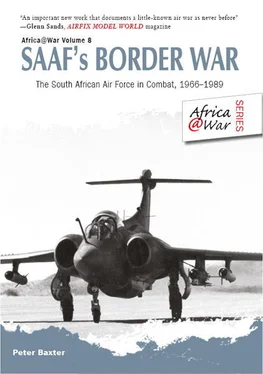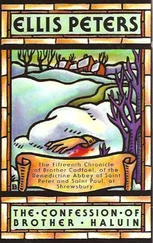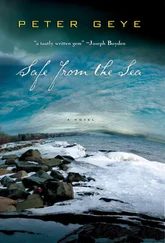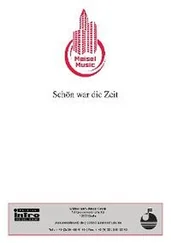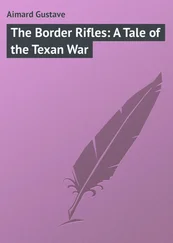The latter point was extremely important in view of the gradual evolution of the Border War. UNITA would grow to occupy an increasingly important role both in terms of its alliance with South Africa and the extent to which this in the months and years to follow would draw South Africa deeper into the Angolan civil war proper.
In the meanwhile, the first major action of 1982 was Operation Super , a somewhat routine affair that grew out of a Special Force reconnaissance insertion into the southern Namibe Province of Angola in order to follow up on intelligence suggesting considerable SWAPO vehicle traffic in the area. The Recces alerted a SWAPO detachment to their presence by laying a vehicle landmine that detonated under the wheels of a passing armoured personnel-carrier. No SWAPO members were injured in the explosion but a follow-up was begun that quickly compromised the Recces, who called in reinforcements from the hard-fighting 32 Battalion. Thereafter, a brisk firefight was fought with the aid of a SAAF Alouette gunship fitted with a 20mm cannon. Once the dust had settled, 21 SWAPO guerrillas were dead, six were captured and one had escaped.
Interrogation of the captured guerrillas revealed a large and previously unknown SWAPO concentration in the rugged Cambêno Valley southeast of the Iona National Park. On 13 March 1982, a mobile Fire Force of 45 men of 32 Battalion, transported in a flotilla of SAAF Puma helicopters supported by Alouette gunships, set off across the dry expanse of the Kaokoveld toward a temporary base established in the Marienflüss Valley, with logistics supplied by a DC-3 Dakota. [18] Fire Force is an airborne assault concept pioneered in the region by the Rhodesian security forces and further developed by South Africa. Its model application involves a highly mobile response force equipped with helicopters and supported by paratroops on permanent standby to respond to intelligence provided either by pseudo or covert reconnaissance missions within an active area.
The infantrymen were dropped by Puma and succeeded in taking the camp in an action that extended over eight hours, supported continuously by Alouette gunships. The fight resulted in the deaths of 201 SWAPO members to the loss of three men of 32 Battalion. A new prospective infiltration route was also comprehensively shut down. Captain Ellis, who had coordinated the air assault from above, and Sergeant Stephen Coetzee were both awarded the Honoris Crux for their actions that day. Three members of 32 Battalion were similarly decorated.
1982 was a year of mixed fortunes for the SAAF. On 1 June an Impala Mk II, piloted by Major Gene Kotze, was successfully brought down by enemy anti-aircraft fire while diving to attack a SWAPO target inside Angola. The aircraft crashed, killing the pilot instantly. Then, two months later, on 9 August, a fully loaded Puma was brought down near Cassinga by either a direct hit from a ground-fired RPG-7 rocket or a 23mm AAA – reports on the matter differ – killing pilot Captain John Twaddle, co-pilot Lieutenant Chris Petersen, technician Sergeant Grobler and all 12 paratroopers on board.
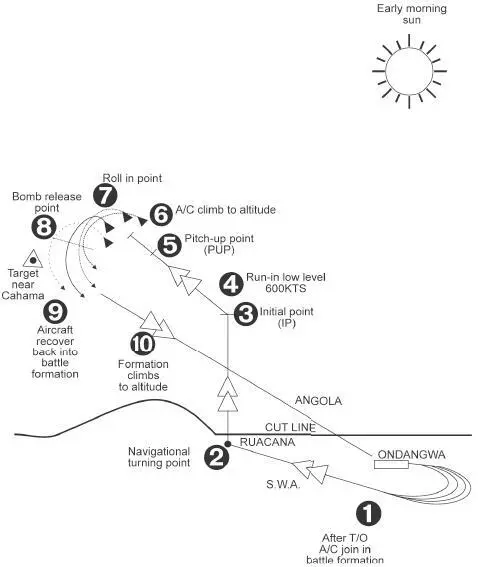
A STRIKE OUT OF THE SUN
On 16 May, eight Mirage AZs and four CZs destroyed enemy 23mm and 57mm AAA positions at Cahama, a constant thorn in the SAAF’s side.
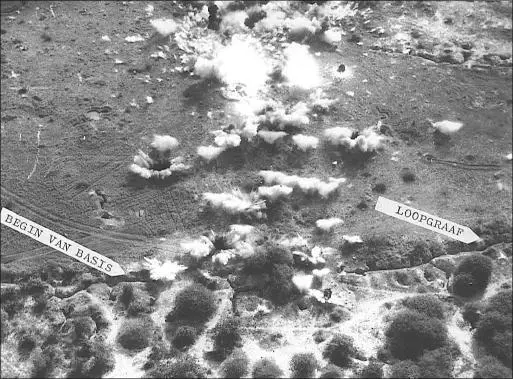
Another strike on Cahama, this time by Canberras.

Armed Impala Mk II aircraft taxiing for take-off at AFB Ondangwa, 1982. Photo: SAAF Museum
Matters were put right, however, when 3 Squadron’s Major Johan Rankin, this time flying with Captain Cobus Toerien as his wingman, successfully brought down another Angolan MiG-21 in aerial combat. On this occasion the F1CZs were tasked to escort an extremely vulnerable and very valuable Canberra on a small-area photo-reconnaissance mission over the Cahama area for the purpose of updating intelligence. At 11h20 the two fighters rendezvoused with the Canberra and, under positive radar control, the three-ship formation set a course for Cahama. Very quickly, however, radar fighter-control picked up approaching enemy aircraft and ordered the Canberra back while instructing the two fighters to climb to 30,000 feet and accelerate to Mach 0.95, the limiting speed for external fuel tanks. This positioned the opposing formations nose-to-nose, 12 nautical miles apart and closing at twice the speed of sound.
Major Rankin observed two MiG-21s on the same level as him, some five nautical miles distant, flashing past on his starboard side. The two F1 pilots shed their drop tanks, went into afterburner and commenced a hard right-hand turn in pursuit. Moments before the two formations crossed, the MiGs fired their missiles but they had no chance then of guiding correctly. In the meanwhile, the F1s completed their 180-degree turn as the MiGs were turning smoothly to the right, preserving their supersonic speed. Radar confirmed that they were inching ahead of the F1s and out of firing range. Unable to close, Rankin switched his intercept radar onto transmit in the hope that the MiG radar warning receiver would alert their pilots and force them to turn into the F1s. This was indeed what happened, whether as a result of the radar warning or simply because they were still focused on intercepting the Canberra, will never be known, but the sudden change of vector allowed the F1s to cut the corner and close the range.
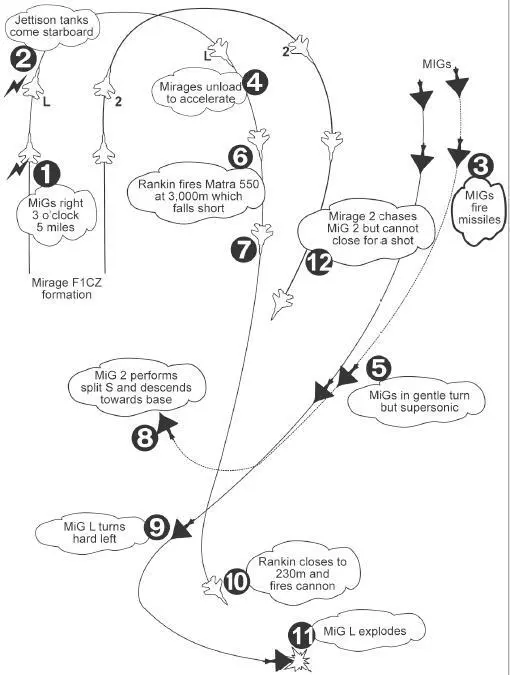
SECOND MiG

Captain Cobus Toerien, Johan Rankin’s wingman.
The two South African fighters then performed an energy acceleration, reaching Mach 1.3 as they entered a curve of pursuit. Rankin made a snap estimation of range and, although his radar had not locked onto the target, he let loose a Matra 550 infrared missile which tracked the MiG until it reached all-burnt range before it fell away. Subsequent examination of the gun-camera footage revealed that the missile had been fired at 3,000 metres, the outer limit of its range at such speeds.
Continuing to close range, however, Rankin fired his second missile from a more practical range of 1,500 metres and this time the missile tracked the MiG which had begun a descending split-S manoeuvre, exploding right behind it.
The MiG was hit, and badly damaged, but still controllable. It slipped the net, continuing its left-hand roll before levelling out and running for home ahead of a trail of smoke. Later intelligence revealed that the damaged craft reached base but was unable to lower its undercarriage and was further damaged in a crash landing.
The remaining MiG, however, still had a fight on its hands and entered a split-S turn to the left with Rankin hard on its tail and overtaking rapidly. At a range of 200 metres the South African opened fire with his 30mm cannons, hitting the MiG which exploded directly in front of him, forcing the F1 through the expanding fireball which resulted in an engine compressor stall. Only after cutting the engine and performing a hot-relight was Rankin back in the game.
Читать дальше
